Performance
Format
The PV-GS35 uses standard DV compression to MiniDV tape. MiniDV compression is certainly the standard of video quality against which all other compression formats are judged. We obviously love the look of MiniDV video, and frankly, this new section is more for those camcorders which use compression types such as MPEG2 or MPEG4 where a lot of information is lost. Of course, there are better formats out there, like DVCAM, DVCPRO, BetaCamSP, etc. and this is why we give all MiniDV camcorders a compression score of 8, instead of 10.
**Media***(8.0)**
*The Panasonic PV-GS35 has the ability to record video to 6.35mm MiniDV tape in both SP and LP modes. Eighty minutes can be recorded in SP mode with 120 minutes available in LP mode. SD cards, ranging from 8 MB to 1 GB, can be used capture digital stills at a resolution of 640 x 480.
**Editing***(8.0)*
Video footage recorded to MiniDV tape can be edited very easily using any of the many editing software suites, most notably Avid and Final Cut Pro, though many manufactures include rudimentary editing software with their products. The PV-GS35 ships with MotionDV Studio 5.3, an example of such elementary software.
Tour
**
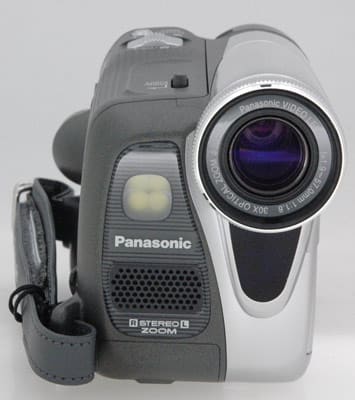
**
The Front*(7.5)*
The front of the PV-GS35 is gray and silver—black on the left, silver on the right. On the top of the gray side is the camcorder’s video light, followed down the front by the camcorder’s stereo microphone. Below the stereo microphone is a port cover, shielding the camcorder’s microphone input and A/V port. The lens protrudes from on the top of the silver side and is adorned with focal length and optical zoom information. Below the lens is an infrared sensor.

**The Right Side***(8.5)*
On the right side of the PV-GS35 is the camcorder’s tape mechanism. It is grooved horizontally and features the camcorder’s long slender strap which runs across the bottom. Underneath the strap is a horizontal port cover concealing the camcorder’s USB and DV ports. Along the top of this mechanism is the automatic/manual mode switch/manual focus slider.
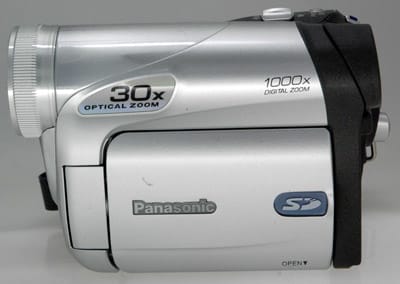
**The Left Side***(8.0)*
The left side of the PV-GS35 is dominated by the camcorder’s LCD screen and panel. When lifted, this panel reveals the camcorder’s SD card port—-which partially wraps around the bottom edge of the LCD cavity—-and its ‘open’ switch. Above the SD card port is a speaker used during on-camcorder playback. Above the LCD panel, the PV-GS35’s lens barrel runs along the top of the left side and protrudes slightly.

The Back*(6.5)*
The back of the PV-GS35 features nearly all of the camcorder’s navigational controls and power sources. The camcorder’s battery port sits squarely in the lower left of the back of the PV-GS35, adjacent to the color electronic viewfinder located above. To the right of the electronic viewfinder are buttons for the quick start function, for access to the camcorder’s menu system, and to turn on the video light. Above these is the camcorder’s on/off switch. Below them rest the camcorder’s newly designed record button, mode dial, and navigational joystick. The record button has been made sleeker, smoother, and more easily accessible than last year’s option. The navigational joystick found on this year’s Panasonic MiniDV camcorders is a great new feature because it is conveniently within thumb’s reach, making the camcorder easily workable using only one hand. Last year, many of the features controlled by the new joystick could only be accessed underneath the camcorder’s LCD screen. Used to toggle between camcorder mode, digital camera mode, camcorder playback mode, digital camera playback mode, and PC connect mode, the mode dial encircles the navigational joystick. Underneath the battery compartment on the PV-GS35 is the camcorder’s S-Video port.
The Top*(7.5)*
The top of the PV-GS35 is both silver and gray. On the left, the lens barrel is covered in silver, while to the right, gray lines the top of the tape mechanism. Toward the back of the tape mechanism, the camcorder’s zoom toggle and photo button are within reach of the user’s middle and index finger, respectively.
Auto/Manual Controls
Picture & Manual Control
Automatic Control*(5.0)*
The PV-GS35 offers automatic control over exposure, gain, focus, and white balance. While there is no easy mode, automatic defaults can be reestablished if the user sets the camcorder to auto mode using the switch on the PV-GS35’s right side. Consistent with last year’s offerings, the PV-GS35 includes auto exposure presets which put more explicit boundaries on the camcorder’s automatic adjustments to exposure, shutter speed, and white balance. Automatic adjustments to white balance take a couple of seconds but provide a nice, subtle shift to fairly accurate shades.
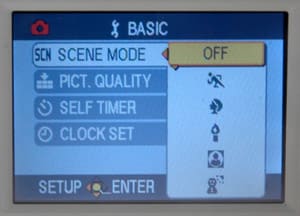
Overall Manual Control*(7.0)*
The PV-GS35 offers tons of manual control for a small MiniDV camcorder in its price range. Manual controls offered include focus, iris, shutter speed, white balance, and gain. While independent adjustment of shutter speed and iris are welcome features on the PV-GS35’s interface, manual control on this camcorder is not without its problems. While the new joystick control makes adjustment easy to do with one hand, it still forces the user to enter a sometimes difficult-to-navigate manual control menu. While I would have liked to see some slower shutter speed options, the manual controls on the PV-GS35 beat the pants off of the controls on many Sony camcorders.
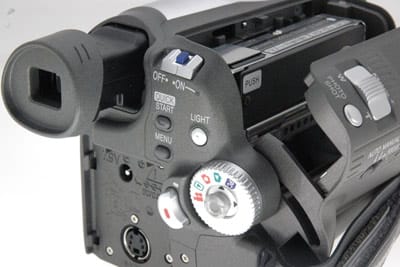
Zoom Control*(7.0)*
The zoom toggle on the PV-GS35 is the same as featured on many of last year’s Panasonic MiniDV camcorders. It is raised enough to allow easy control over the zoom speed, though it is most easily accessed with the user’s middle finger. I would have liked it to be accessible with my index finger, a finger with which I feel more comfortable controlling zoom.
Zoom Power/Ratio*(30.0)*
The Panasonic PV-GS35 has an impressive 30x optical zoom with a 1000x digital zoom.
Focus*(5.0)*
Manual focus on the PV-GS35 is accessed through a slider located on upper left of the right side of the camcorder. Focus can instantly be manually operated by pulling this slider past the manual mode indicator and releasing. Not only will this action manually focus the camcorder to whatever is central to its immediate vision, but it will also put the camcorder in manual mode, specifically, in the manual focus section of the manual control menu. In this section, the joystick can be used to move through the focal spectrum, an ‘MF’ icon will appear on the LCD screen, and the user can toggle through the focus as well as other manual adjustments. Unfortunately, there are no numerical values to guide the user through the focal range.
Exposure (Aperture) (6.0)
Manual exposure is available on the PV-GS35. F-stop options of Open, f/2.0, f/2.4, f/2.8, f/3.4, f/4.0, f/4.8, f/5.6, f/6.8, f/8.0, f/9.6, f/11, f/14, and f/16 are all available, but unfortunately like a lot of the manual control on the PV-GS35 they are kind of annoying to get to. It would be a pain to access them during recording. There are smaller increments between each F-stop, which lack numerical F-stop values, and similar options are available in digital camera mode. While the joystick is okay for adjustment, some sort of dial would offer better control over these options.
Shutter Speed*(7.0)*
Shutter speed options of 1/60, 1/100, 1/120, 1/180, 1/250, 1/350, 1/500, 1/750, 1/1000, 1/1500, 1/1/2000, 1/3000, 1/4000, and 1/8000 exist on the PV-GS35. In still camera mode, options from 1/30, 1/60, 1/100, 1/120, 1/180, 1/250, 1/350, and 1/500 are available. On a camcorder this small, these are some impressive options; however, I would have liked to see some slower shutter speed options. Adjustment is made through the same method as exposure, white balance, and gain: by using the new joystick. While this method is okay, and certainly better than last year’s, I would have liked to see a dial of some sort, perhaps similar to that of the PV-DV103.
White Balance*(7.0)*
White balance options on the PV-GS35 include indoor (light bulb icon), outdoor (sun icon), Auto (AWB icon), and Manual (one push icon). These options are accessible in the manual control menu system, by pressing straight down on the joystick.
Gain*(7.0)*
Once the aperture is Open, manual gain options include: 0dB, 3dB, 6dB, 9dB, 12dB, 15dB, and 18dB with smaller increments in between each setting which lack numerical delineation. For Panasonic to offer manual gain control on a camcorder this small is great and is something Panasonic has been doing for years, but I must warn the reader to use this feature sparingly, as excess gain means excess noise.

Other Manual Control*(0.0)*
Wasn’t the above enough for you? Aside from the slew of manual controls mentioned above, the PV-GS35 doesn’t include any other manual options.
Still Features
Still Features*(6.5)*
Stills can be captured to SD card in both digital camera mode and during video recording in camcorder mode on the PV-GS35. Capture to the SD card is at a resolution of 640 x 480 during tape recording and in card mode. With the included RapidFire Consecutive Photoshot, users can take up to ten photos at a half second interval (if 1/30 shutter is selected, only 0.7 second intervals are available). In card playback mode, the PV-GS35 includes a Slide Show feature with which the user can view his or her recorded stills sequentially at an interval. Although the PV-GS35 does offer an SD card slot, and that’s all fine and good, I would not recommend buying this camcorder based on this ability. The stills it captures are of low quality and can be bested by nearly any dedicated digital camera.
Still Resolution*(1.4)*
In the same way that we tested the video resolution of the PV-GS35 above, we tested the resolution of still images taken to SD card. The PV-GS35 captures still images to SD card at 640 x 480. When these stills were processed by Imatest Imaging Software, they gave us 140,800 pixels (0.1408 Megapixels) of resolution. It should be noted that this is "real resolution," and although it differs from the reported resolution of the camcorder (307K pixels at 640 x 480), it is not an unusual reading as all imaging products perform worse in our tests than in the manufacturer’s report.

Still Performance*(4.0) *
The only still resolution available for capture on the PV-GS35’s SD card is the standard 640 x 480, and the results are pretty good for a camcorder with only a 1/6 inch 680K pixel CCD. In fact, for such a 1 chip camcorder the PV-GS35 performs down right admirably. Its 640 x 480 stills, while not as vibrant, crisp, or free of noise as the PV-GS65’s (a 3 chip camcorder) 640 x 480 image, it is still very good. The image shows good color information with not nearly as much grain as some comparable 1 chip camcorders this year. For instance, compare this with JVC’s GR-D270’s 640 x 480 image. The PV-GS35 shows much less noise and drastically better colors (look at the reds).

Handling and Use
Ease of Use*(4.0)*
The new navigational control joystick on Panasonic’s new MiniDV camcorders this year really improved their ease of use. These camcorders, the PV-GS35 included, can now be operated easily with one hand. This bumps up the appeal for point-and-shooters. For those who need lots of manual control, however, the PV-GS35 does not offer the same ease of adjustment for its manual options. It should be noted that there are tons of manual options on the PV-GS35, for those not turned off by the tedious process of accessing them. A period of adjustment might be needed as the user begins to decipher Panasonic’s menu icons; buying this camcorder without a manual is not recommended, though PDF documents of the manual should be available online at some point.
Handling*(8.5)*
The new navigational feature on Panasonic’s MiniDV camcorders drastically improves handling from last year’s camcorders. While manual controls are still trapped in a menu system, the new joystick makes one-handed operation and adjustment very easy. Both the new joystick and the camcorder’s record button are ergonomically designed and very well placed on the camcorder’s body. I would have liked to see the zoom toggle located under my index finger rather than my middle finger, but I guess I’ll have to deal. The PV-GS35 didn’t fit into my hand as well as some of Panasonic’s new 3 CCD camcorders, but it was pretty close.
Portability*(7.0)*****
The PV-GS35 is fairly portable. It might not be as portable as some of Canon’s and Sony’s new MiniDV camcorders, but for Panasonic, this is about as small as you can get. It is similar in size to last year’s low-end GS line camcorders.
LCD/Viewfinder*(6.0)*
The PV-GS35 includes a 2.5-inch LCD screen and a color electronic viewfinder. The PV-GS35 and PV-GS31 both have color viewfinders, as opposed to the black-and-white viewfinder found on the PV-GS19. The LCD screen, unfortunately, solarizes if viewed from an angle, and the viewfinder can only extend directly backwards about three quarters of an inch. As such, the viewfinder can barely protrude past the PV-GS35’s battery.
Battery Life*(7.2)*
Recording video to tape with the LCD screen open, and without zooming, a fully-charged and included CGA-DU12 battery pack gave up a little over two and half hours of video recording (2 hr., 30 min, 29 sec.).
Audio/Playback/Connectivity
Audio*(6.5) *
Audio option for both 12 and 16 bit capture are available on the PV-GS35 and are accessed through the menu system. Unfortunately, manual control of audio levels does not exist in the PV-GS35. Audio Dubbing is available when using the remote in case you need cool voice-overs and such. The PV-GS35 features a microphone port located on the front of the camcorder, under a port cover, though no accessory shoe is available, meaning that any microphone you attach will unfortunately have to be handheld. Audio Dubbing is available on the PV-GS35. The PV-GS35 also has a microphone input which is great, considering that the $500 offerings from Canon, JVC, and Sony all lack this feature. In addition the camcorder has a headphone out jack that is shared with the A/V out jack. The PV-GS35 really offers great audio options.
VCR Mode*(6.5) *
Playback modes for both SD card and tape capture are available for on-camcorder and off-camcorder playback on the PV-GS35. These modes are selected using the mode dial, with playback options toggled using the joystick control and zoom control (volume). With controls as such, the PV-GS35’s playback modes can be used easily with one hand for easy playback to check and see if you got that one shot. The A/V port on the front of the camcorder and the S-Video port in the rear allow for playback on televisions. Computer editing and manipulation is available using the DV port and USB port, both located under the strap. Thumbnail playback of card captured still images, as well as formatting and editing options, are available on PV-GS35. Slow-motion/frame-by-frame playback is available with the camcorder’s remote.
Ports*(8.0)*
The PV-GS35 includes an S-Video port underneath the battery port on the back of the camcorder. A microphone input and an A/V output are located under a port cover on the front of the camcorder. Underneath the strap of the PV-GS35 is a port cover concealing the camcorder’s USB and DV ports. The PV-GS35 is the only low-end GS camcorder with a microphone input port, though it lacks an accessory shoe.
**
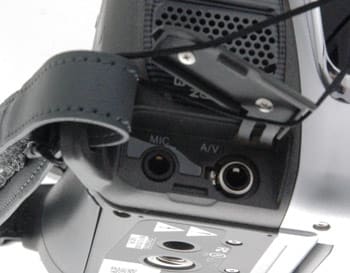
**
Other Features
Widescreen/16:9 Mode*(5.0)*
The PV-GS35 offers cinema effect within its menu system. When selected, this effect letterboxes the image (adds black bars to the top and bottom). Canon’s low-end MiniDV camcorders all offer their "High-Resolution 16:9" modes, which beat this letterboxing.

4:3 standard aspect ratio

Cinema/Widescreen Mode Aspect Ratio
Scan Rates/24P*(0.0)**
*The PV-GS35 does not offer recording in 24P (24 progressive) or any 24P-like effect to stimulate cinema-like capture. Video is captured at 60 interlaced fields per second each with 525 lines of resolution.
**
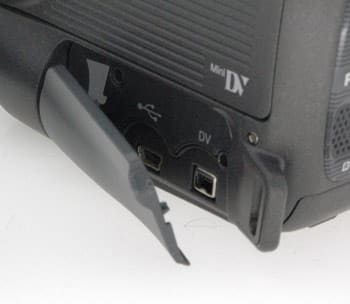
**
Other Features*(6.0)*
Backlight: This feature brightens the image slightly, as in a backlit situation. It is indicated by the sun icon.
*Quick Start: *This feature, accessed on the back of camcorder, makes startup quicker when necessary, and helps point-and-shooters get that important on-the-go shot.
*New Menu System: *Panasonic has overhauled their old menu system, offering a new, improved, more aesthetically pleasing one.
*Magic Pix: *This is the night mode of the PV-GS35. Accessed in the manual control menu by selecting the icon with the crescent moon and star, this feature slows the shutter speed significantly and boosts the gain to offer a brighter image. The PV-GS35 lacks Panasonic’s Magic Pix 0 lux, which would turn the LCD screen white so it can be flipped around and used as a light source.
*Fade In/Out:* This feature allows the user to fade in and out of a given shot. Indicated by the icon of an arrow within a box on the LCD screen, this feature is available in the camcorder’s manual control menu.
*Wind Cut:* This feature reduces audio noise captured on the camcorder’s stereo microphone in outdoor conditions. It can be turned on and off in the camcorder’s menu system.
*Image Stabilization: *The PV-GS35 offers electronic image stabilization, which can be toggled on and off within the camcorder’s menu system.
*RapidFire Consecutive Photoshot:* This feature allows the user to capture up to 10 pictures at an interval of a half a second. If the manual shutter feature is set to 1/30, only a 0.7 interval is available.
*Webcam: *The PV-GS35 can be used as a webcam.
Comparisons/Conclusion
Comparisons
Panasonic PV-GS15
The PV-GS35 is very similar to the PV-GS15 from last year. They share similar images, manual controls, and test results. While there are subtle differences in their tests, their individual pros and cons average out. The PV-GS35 does have some distinct factors that distinguish it from the PV-GS15, namely an unprecedented 30x optical zoom and a tremendously better navigational system.
Panasonic PV-GS65
Panasonic’s cheapest 3 CCD camcorder this year, the PV-GS65, includes the same navigational system and handling pluses that are seen on the PV-GS35, but with the 3 CCDs, it offers tremendously better video for only a slightly bigger price. The PV-GS65 also offers still image capture at a better resolution of 1280 x 960. The PV-GS65 does not include the zoom mic function found on the PV-GS35, though it does have a cold accessory shoe, making the camcorder’s microphone input a bit more practical than the PV-GS35’s.
Sony DCR-HC32
Sony’s DCR-HC32 offers a similarly-sized CCD as Panasonic’s PV-GS35 and will likely perform similarly. In the manual control department, however, this year’s Sony MiniDV camcorders maintain the same lack of manual shutter speed and independent iris control found on last year’s models. Additionally, the DCR-HC32 has Sony’s touch screen menu system, which, while offering cool features like Spot Metering and Spot Focusing, hinders manual adjustment. The DCR-HC32 includes an optical zoom of 20x to the PV-GS35’s 30x. The PV-GS35 really wins on options, giving you way better manual control and audio options where the Sony gives none.
*Canon ZR300
*The Canon ZR300 is available at the same price as the Panasonic PV-GS35. While the two camcorders share similarly sized imagers, I harbor some skepticism as to whether or not this year's ZRs can perform as well as this year's Panasonics. Of course, this is mere speculation, but last year's ZRs share imagers with this year's ZRs and the former performed horribly in low light conditions. On top of this, the ZR300 features no microphone input or S-Video port, has a 22x (rather than 30x) optical zoom, and offers fewer, lower-quality manual controls. There are some good things going for the ZR300, namely the inclusion of the same High-Resolution 16:9 mode found on last year's Optura 400 and 500. This beats the PV-GS35's letterboxed 16:9 mode. Also, the ZR300 includes a jog dial for menu navigation, and while the PV-GS35's new navigational method makes one-handed camcorder use easier, the ZR300's jog dial may make focal adjustments a bit easier. The deciding factor, though, is low light performance. We'll see how the ZR300 does when we get into the testing room.
JVC GR-D295
Finally, available for the same price as the PV-GS35, JVC's most expensive camcorder in its Compact series, the GR-D295, ships with a CCD similar to last year's JVC low-end MiniDV camcorders and the PV-GS35. While this may sound like good news considering last year's JVC camcorders' excellent low light performance, it should be noted that on the GR-D295, JVC has removed the 3D Noise Reduction technology found on last year's camcorders, making me a little skeptical of its otherwise auspicious specifications. Additionally, the camcorder doesn't feature a microphone input and has a pretty pathetic button navigational system, though manual control offerings could be worse. It is also bottom-loading, which is a bummer.
Who It's For
Point-and-Shooters (7.5)
The PV-GS35 is one of the more versatile point-and-shoot camcorders this year. While it doesn’t offer the easy mode most point-and-shooters love, it does include an auto mode, and its superb handling really makes the camcorder a breeze to operate with one hand. Also, Panasonic has improved last year’s menu system significantly which makes menu navigation, if necessary, pretty easy and clear.
Budget Consumers (6.5)
While certainly not the cheapest 1 chip MiniDV camcorder made by Panasonic this year, the PV-GS35 does include some features which make it a good deal for the cash you throw down for it. These include a S-Video port, a SD card port, and a 30x optical zoom.
Still Photo / Video Camera Hybrid (2.0)
While the PV-GS35 does include a SD card port, we cannot recommend it for its still capabilities. It records stills to card at 640 x 480, a resolution easily bettered by any dedicated digital still camera.
Gadget Freak (7.0)
The massive optical zoom on the PV-GS35 is pretty impressive as a gadget; however, essentially, the PV-GS35 is a standard Panasonic MiniDV camcorder.
*Manual Control Freaks (8.0)*
The Panasonic PV-GS35 offers a wealth of manual control for such a small, lower-tier MiniDV camcorder. It has more manual controls than any other manufacture’s lower-tier MiniDV camcorder.
Pros / Serious Hobbyists (5.5)
For a serious hobbyist, we cannot recommend the PV-GS35; we recommend that they look to the cheaper Panasonic 3 chip camcorders for a backup camcorder.
**Conclusion
**The PV-GS35 is a great 1 chip MiniDV camcorder with a recording breaking and astounding 30x optical zoom. Although otherwise, the PV-GS35 doesn’t see many upgrades from last year’s PV-GS15 - it maintains last year's stability. For instance, the imager, the ports, and manual controls offered are identical. But, the few upgrades that the PV-GS35 offers, namely the 30x optical zoom and the new navigational systems, hit key areas which needed improvement from last year. Panasonic was already providing decent low light performance, but their camcorders last year really suffered from a bad navigational system. This year Panasonic has overhauled not only the menu system of these camcorders, of which the PV-GS35 is the flagship, but also the method with which this system is navigated, namely, with the addition of the joystick. Now the camcorder can be operated smoothly with one hand, and it can zoom in really, really far. With reductions from other manufacturers in the features they offer, the PV-GS35 looks even more attractive than last year's Panasonic. The $500 Sony DCR-HC32, Canon ZR300, and JVC GR-D295 all don't offer a microphone input or headphone out, but the PV-GS35 gives you both. Add this to awesome manual control and an a record breaking 30x optical zoom, and Panasonic has really worked to bridge the gap between manual control lovers, which they have attracted in the past, and point-and-shooters who have been discouraged in the past with the handling ability and convenience of Panasonic’s 1 chip camcorders’.
Meet the tester

Matt Culler
Editor
Matt Culler is a valued contributor to the Reviewed.com family of sites.
Checking our work.
Our team is here for one purpose: to help you buy the best stuff and love what you own. Our writers, editors, and lab technicians obsess over the products we cover to make sure you're confident and satisfied. Have a different opinion about something we recommend? Email us and we'll compare notes.
Shoot us an email